#US Interior Secretary
Explore tagged Tumblr posts
Text
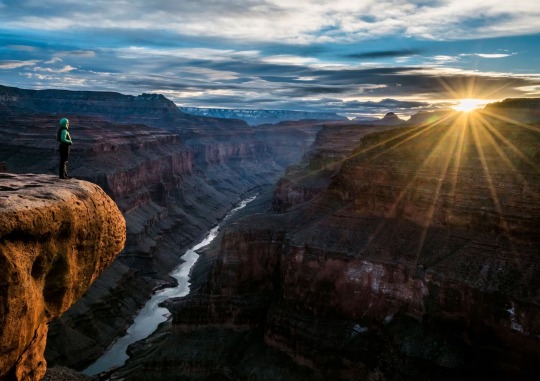
A new national monument adjacent to the Grand Canyon will honor tribal history and protect important habitats. Photograph By Pete McBride, National Geographic Image Collection
1 Million Acres of ‘Sacred’ Land Near Grand Canyon Are Receiving New Protections
The designation of the land as a national monument, confirmed to National Geographic this week by the White House, will prevent new uranium mines and protect historically significant tribal lands.
— By Dina Fine Maron | August 8, 2023
The White House is set to declare today that nearly one million acres of public land adjacent to Grand Canyon National Park will become the country’s newest national monument. The move, first confirmed to National Geographic by the White House, will honor Indigenous homelands in northern Arizona and protect the site from any new uranium mining projects.
The site encompasses natural habitat for the critically endangered California condor, and it is an important watershed for the Colorado River, which provides water to 40 million Americans. It’s also habitat for desert bighorn sheep, and birds including the threatened western yellow-billowed cuckoo and the endangered southwestern willow flycatcher.
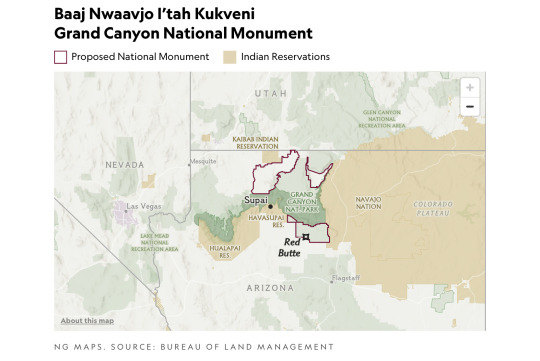
The decision by President Joe Biden is the culmination of a lobbying effort by a dozen tribes who have historical ties to the region and advocated for its monument status. It will be called Baaj Nwaavjo I’tah Kukveni Grand Canyon National Monument. Baaj nwaavjo (BAAHJ – NUH-WAAHV-JOH) means “where Indigenous peoples roam” in the Havasupai language, and i’tah kukveni (EE-TAH – KOOK-VENNY) means “our ancestral footprints” in the Hopi language.
The name generally translates as the Ancestral Footprints of the Grand Canyon National Monument.
“Being part of this announcement means everything to me,” says Interior Secretary Deb Haaland, the first Native American cabinet secretary. “I am filled with gratitude for President Biden’s dedication to Indigenous peoples and his understanding of our unbreakable ties to our ancestral homelands.” (Haaland is a member of the Pueblo of Laguna, which is not one of the tribes with ties to this site.)
“After the establishment of Grand Canyon National Park in 1919, the Havasupai people were driven out from their lands,” Haaland says. “Their story is one that is similar to many tribes in the Southwest who trace their origins to the Grand Canyon and the plateaus and the tributaries that surround it. These special places are not a passthrough on the way to the Grand Canyon; they are sacred and significant and deserve protection.”
The monument will include a variety of sacred sites including Red Butte, which the Havasupai people consider their birthplace and call Red Butte-Wii’i Gwdwiisa. They traditionally camped there in the wintertime, before they were forcibly relocated by the U.S. government.
“Our creation stories say Red Butte-Wii’i Gwdwiisa belongs to Mother Earth, and we believe if mining occurs there it will puncture the lungs of Mother Earth,” says Carletta Tilousi, the Grand Canyon tribal coalition coordinator and a Havasupai tribe member. “My family are descendants of the removal,” she adds. “My grandmother’s sisters, my aunts used to talk about how they were treated … One would always say they had guns pointed at them, so it was a very scary and hostile time for my people.”
The Making of a Monument
In April 2023 a coalition that included the 12 tribes with historic ties to the Grand Canyon unveiled their proposal for this national monument at a press conference where Arizona Senator Krysten Sinema and Arizona Representative Raúl Grijalva, both Democrats, also spoke in support of the initiative.

The Havasupai Indian Reservation in Arizona, which includes the Havasu Waterfall—part of the Havasupai Falls—is the current home of the Havasupai people. After the Grand Canyon became a national park, they were forcibly removed from their traditional homelands in the canyon and in nearby lands that will be part of the new national monument. Photograph By Mike Theiss, National Geographic Image Collection
The group invited Haaland to visit the proposed monument site, which she did in May. That visit, Haaland says, was “one of the most meaningful trips of my life.” She hiked to Supai, the capital of Havasupai Indian Reservation, and visited with the tribal council and chairman. She also hiked to some of the reservation’s waterfalls, where she says she immersed herself in the “sacred blue-green waters that flow from the spring-fed streams.”
“I witnessed the deep connection that the Havasupai people have with the land and the waters that have sustained them,” she says. The monument, “will honor and protect the ancestral homelands of 12 sovereign tribal nations, help address past injustices, and create an abiding partnership between the U.S. and the region's tribal nations in caring for these lands.”
“Our work for Indian country is far from over, but the progress we’ve accomplished under this Administration is historic,” she adds.
The White House proclamation creating the monument, which the president is expected to sign later today, will establish a tribal commission to provide guidance on the development and implementation of the monument’s management plan.
“These Special Places are Not a Pass Through on The Way to The Grand Canyon; They are Sacred and Significant and Deserve Protection.”
— Deb Haaland, Interior Secretary
Halting Mining Operations
The monument will be on federal public lands, and it will make permanent President Barack Obama’s 20-year moratorium on new mining operations in the area from 2012. Existing mining claims that predate the moratorium will remain in place, however, and the White House says that there are two approved mining operations within the boundaries of the monument which could still operate.
The legacy of uranium mining in the area has had significant health repercussions. Native people working in the mines during the Cold War-era uranium extraction heyday have had elevated cases of cancer and respiratory illnesses.
Data from the U.S. Geological Survey further indicates that there are multiple areas around the Grand Canyon where uranium leached into the ground water and rendered waters unsafe for drinking.
Any mining, according to tribal communities in the area, puts health, safety, and the environment at risk, and it compromises historic homelands, cultural and archaeological sites, and ceremonial lands.
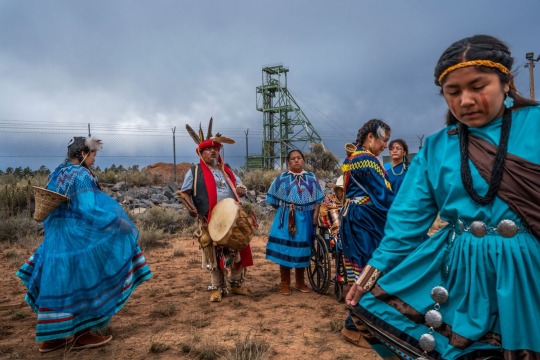

Top: A group of Havasupai, whose reservation lies near the Grand Canyon, protest mine development in the area. Havasupai Tribe member Carletta Tilousi (second from right) says mines have poisoned waters in the region. Bottom: Decades of uranium mining around the Grand Canyon have impacted waters, local ecosystems, and historic tribal lands. Photographs By Pete McBride, National Geographic Image Collection
Arizona Representative Paul Gosar, a Republican, publicly opposed the new monument proposal before the announcement and said presidential declarations like this circumvent congressional authority. Uranium mining proponents have also opposed the proposal, saying this will be a missed economic opportunity for people in the area.
The Antiquities Act of 1906 authorizes the president to declare monuments on federal lands if they contain historic landmarks, structures, or other objects of historic or scientific interest.
“The Antiquities Act allows us to look toward the future, so if there are [mining] claims that were already made and perfected through the normal process, those would not be disrupted, and this does not impact private property at all,” says Brenda Mallory, chair of the U.S. Council on Environmental Quality.
The Grand Canyon, with its breathtaking views, is one of the most famous parks in America. It attracts about six million visitors each year. President Teddy Roosevelt, standing on the South Rim in 1903 proclaimed, “Leave it as it is. You cannot improve on it.”
Mallory says that the landscape, species, and the type of ecology at the new monument are very similar to what visitors would see in the nearby Grand Canyon, but she also notes the important tribal history in the area. “It’s the Grand Canyon—extended,” she says.
#Protection of Sacred Land#Historical#Significant#Tribal#Lands#Grand Canyon#Indigenous#Northern Arizona#National Geographic#Colorado River#Critically Endangered California Condor#Yellow-Billowed Cuckoo#Flycatcher#Bighorn Sheep#US President Joe Biden#Baaj Nwaavjo I’tah Kukveni#Grand Canyon National Monument#Ancestral Homelands#Interior Secretary Deb Haaland#Havasupai People#Red Butte-Wii’i Gwdwiisa#Mother Earth#Carletta Tilousi#Arizona Representative Raúl Grijalva (D)#Arizona Senator Krysten Sinema (D)#12 Sovereign Tribal Nations#Halting Mining Operations#President Barack Obama#Cold War-Era Uranium Extraction#Historic Homelands | Cultural & Archaeological Sites | Ceremonial Lands
2 notes
·
View notes
Text
So rn the US government is starting to defund the National Parks Service, and while this is a bad thing largely because it's mainly being done to open up the possibility of oil drilling in a lot of those areas, I think it also needs to be said that no the National Parks Service was not just there to "protect natural wonders" or whatever. It was there because a lot of those places are incredibly important land to a lot of Indigenous Peoples and if you give it special status that means you can't live on it you can make the natives leave easier because they get arrested if they don't. Like I am very much not in favor of this change as it is being done but I don't think we should respond to it with wholehearted praise of the National Parks System either. Please know the history of the land you live on and visit.
edit: this post was made with some noteworthy gaps in knowledge. This has already spread so to some extent the damage has been done but I do want to add on an addition someone made that I think does give some very helpful context to this. If you've already reblogged this I recommend doing so again with this addition. Credit on the comment goes to @kingsonne-zedecks
"I think that only two thirds of the conversation is being represented in this post and just wanted to ensure that people had the full picture.
Because the National Parks were absolutely used as a method for limiting, oppressing, and controlling indigenous lands ever since the US government violated multiple treaties to create Yellowstone. "Protecting" these lands meant protecting them from their historical stewards and inhabitants as well as from logging and mining companies.
Multiple parks were even created with provisions "allowing" indigenous people to continue using them for hunting, fishing, gathering, and spiritual purposes. Except that they were rapidly pushed out in the following years, while the tourists were told of the indigenous in the past tense only.
That's all absolutely true and is an important part of the history of the National Park Service that should not be forgotten or ignored.
But.
Its also not 1872 anymore. In 2015 Mt McKinley was offocially recognized and restored to the name Denali. Something that, though small in comparison to the harm that has been done, was indicative of a growing sentiment for restoring Ingigenous history. In 2021 Chuck Sams and Deb Haaland were put into office as the first Indigenous leader of the National Park Service and Secretary of the Department of the Interior respectively. By the end of 2024 we had over 250 co-stewarship agreements in place with various Indigenous Nations for management and use of these lands. Educational resources in visitors centers across the country were reworked to more accurately represent the indigenous history of the parks. Things were unequivocally moving in a positive direction.
While the History of the National Park Service as a tool of colonialization is important to recognize. The Trump Administration is not defunding that same tool. That tool does not exist today exactly as it once did.
The attack on the National Park Service of today is itself an attack on Indigenous people and an attack on progress. As blatant as the executive order to rename Denali back to McKinley."
4K notes
·
View notes
Text
Things the Biden-Harris Administration Did This Week #32
August 30-September 6 2024.
President Biden announced $7.3 billion in clean energy investment for rural communities. This marks the largest investment in rural electrification since the New Deal. The money will go to 16 rural electric cooperatives across 23 states Alaska, Arizona, California, Colorado, Florida, Illinois, Indiana, Iowa, Kentucky, Michigan, Minnesota, Montana, Nebraska, New Jersey, New Mexico, Nevada, North Dakota, Ohio, Pennsylvania, South Dakota, Texas, Wisconsin, and Wyoming. Together they will be able to generate 10 gigawatts of clean energy, enough to power 5 million households about 20% of America's rural population. This clean energy will reduce greenhouse emissions by 43.7 million tons a year, equivalent to removing more than 10 million cars off the road every year.
The Biden-Harris Administration announced a historic 10th offshore wind project. The latest project approved for the Atlantic coast of Maryland will generate 2,200 megawatts of clean, reliable renewable energy to power 770,000 homes. All together the 10 offshore wind projects approved by the Biden-Harris Administration will generation 15 gigawatts, enough to power 5.25 million homes. This is half way to the Administration's goal of 30 gigawatts of clean offshore wind power by 2030.
President Biden signed an Executive Order aimed at supporting and expanding unions. Called the "Good Jobs EO" the order will direct all federal agencies to take steps to recognize unions, to not interfere with the formation of unions and reach labor agreements on federally supported projects. It also directs agencies to prioritize equal pay and pay transparency, support projects that offer workers benefits like child care, health insurance, paid leave, and retirement benefits. It will also push workforce development and workplace safety.
The Department of Transportation announced $1 billion to make local roads safer. The money will go to 354 local communities across America to improve roadway safety and prevent deaths and serious injuries. This is part of the National Roadway Safety Strategy launched in 2022, since then traffic fatalities have decreased for 9 straight quarters. Since 2022 the program has supported projects in 1,400 communities effecting 75% of all Americans.
The Department of Energy announced $430 million to support America's aging hydropower. Hydropower currently accounts for nearly 27% of renewable electricity generation in the United States. However many of our dams were built during the New Deal for a national average of 79 years old. The money will go to 293 projects across 33 states. These updates will improve energy generation, workplace safety, and have a positive environmental impact on local fish and wildlife.
The EPA announced $300 million to help support tribal nations, and US territories cut climate pollution and boost green energy. The money will support projects by 33 tribes, and the Island of Saipan in the Northern Mariana Islands. EPA Administer Michael S. Regan announced the funds along side Secretary of the Interior Deb Haaland in Arizona to highlight one of the projects. A project that will bring electricity for the first time to 900 homes on the Hopi Reservation.
The Biden-Harris Administration is investing $179 million in literacy. This investment in the Comprehensive Literacy State Development Grant is the largest in history. Studies have shown that the 3rd grade is a key moment in a students literacy development, the CLSD is designed to help support states research, develop, and implement evidence-based literacy interventions to help students achieve key literacy milestones.
The US government secured the release of 135 political prisoners from Nicaragua. Nicaragua's dictator President Daniel Ortega has jailed large numbers of citizens since protests against his rule broke out in 2018. In February 2023 the US secured the release of over 200 political prisoners. Human rights orgs have documented torture and sexual abuse in Ortega's prisons.
The Justice Department announced the disruption of a major effort by Russia to interfere with the 2024 US Elections. Russian propaganda network, RT, deployed $10 million to Tenet Media to help spread Russian propaganda and help sway the election in favor of Trump and the Republicans as well as disrupting American society. Tenet Media employs many well known conservative on-line personalities such as Benny Johnson, Tim Pool, Lauren Southern, Dave Rubin, Tayler Hansen and Matt Christiansen.
Vice-President Harris outlined her plan for Small Businesses at a campaign stop in New Hampshire. Harris wants to expand from $5,000 to $50,000 tax incentives for startup expenses. This would help start 25 million new small business over four years.
#Thanks Biden#Joe Biden#kamala harris#climate change#climate action#wind power#Russia#human rights#politics#US politics#america politics#worker's rights#road safety
1K notes
·
View notes
Text

Statement from Yosemite NPS workers:
“The purpose of this exercise of free speech is to disrupt without violence and draw attention to the fact that public lands in the United States are under attack," it reads. "The Department of the Interior issued a series of secretarial orders that position drilling and mining interests as the favored uses of America's public lands and threaten to scrap existing land protections and conservation measures. Firing 1,000s of staff regardless of position or performance across the nation is the first step in destabilizing the protections in place for these great places."
"These losses, while deeply personal and impactful, may also be invisible to visitors and members of the public — we are shining a spotlight on them by putting a distress flag on El Capitan in view of Firefall. Think of it as your public lands on strike."
Link: https://www.sfchronicle.com/outdoors/article/yosemite-protest-job-cuts-20180229.php
#national park#national park service#yosemite#protest#trump regime#musk coup#christofascists#antifascist
417 notes
·
View notes
Text
A taxonomy of corporate bullshit
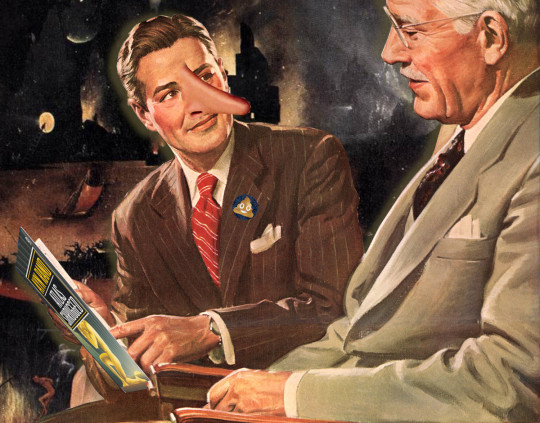
Next Tuesday (Oct 31) at 10hPT, the Internet Archive is livestreaming my presentation on my recent book, The Internet Con.

There are six lies that corporations have told since time immemorial, and Nick Hanauer, Joan Walsh and Donald Cohen's new book Corporate Bullsht: Exposing the Lies and Half-Truths That Protect Profit, Power, and Wealth in America* provides an essential taxonomy of this dirty six:
https://thenewpress.com/books/corporate-bullsht
In his review for The American Prospect, David Dayen summarizes how these six lies "offer a civic-minded, reasonable-sounding justification for positions that in fact are motivated entirely by self-interest":
https://prospect.org/culture/books/2023-10-27-lies-my-corporation-told-me-hanauer-walsh-cohen-review/
I. Pure denial
As far back as the slave trade, corporate apologists and mouthpieces have led by asserting that true things are false, and vice-versa. In 1837, John Calhoun asserted that "Never before has the black race of Central Africa, from the dawn of history to the present day, attained a condition so civilized and so improved, not only physically, but morally and intellectually." George Fitzhugh called enslaved Africans in America "the freest people in the world."
This tactic never went away. Children sent to work in factories are "perfectly happy." Polluted water is "purer than the water that came from the river before we used it." Poor families "don't really exist." Pesticides don't lead to "illness or death." Climate change is "beneficial." Lead "helps guard your health."
II. Markets can solve problems, governments can't
Alan Greenspan made a career out of blithely asserting that markets self-correct. It was only after the world economy imploded in 2008 that he admitted that his doctrine had a "flaw":
https://www.pbs.org/newshour/show/greenspan-admits-flaw-to-congress-predicts-more-economic-problems
No matter how serious a problem is, the market will fix it. In 1973, the US Chamber of Commerce railed against safety regulations, because "safety is good business," and could be left to the market. If unsafe products persist in the market, it's because consumers choose to trade safety off "for a lower price tag" (Chamber spox Laurence Kraus). Racism can't be corrected with anti-discrimination laws. It's only when "the market" realizes that racism is bad for business that it will finally be abolished.
III. Consumers and workers are to blame
In 1946, the National Coal Association blamed rampant deaths and maimings in the country's coal-mines on "carelessness on the part of men." In 2003, the National Restaurant Association sang the same tune, condemning nutritional labels because "there are not good or bad foods. There are good and bad diets." Reagan's interior secretary Donald Hodel counseled personal responsibility to address a thinning ozone layer: "people who don’t stand out in the sun—it doesn’t affect them."
IV. Government cures are always worse than the disease
Lee Iacocca called 1970's Clean Air Act "a threat to the entire American economy and to every person in America." Every labor and consumer protection before and since has been damned as a plague on American jobs and prosperity. The incentive to work can't survive Social Security, welfare or unemployment insurance. Minimum wages kill jobs, etc etc.
V. Helping people only hurts them
Medicare will "destroy private initiative for our aged to protect themselves with insurance" (Republican Senator Milward Simpson, 1965). Covid relief is unfair to people that are currently in the workforce" (Republican Governor Brian Kemp, 2021). Welfare produces "learned helplessness."
VI. Everyone who disagrees with me is a socialist
Grover Cleveland's 2% on top incomes is "communistic warfare against rights of property" (NY Tribune, 1895). "Socialized medicine" will leave "our children and our children’s children [asking] what it once was like in America when men were free" (Reagan, 1961).
Everything is "socialism": anti-child labor laws, Social Security, minimum wages, family and medical leave. Even fascism is socialism! In 1938, the National Association of Manufacturers called labor rights "communism, bolshevism, fascism, and Nazism."
As Dayen says, it's refreshing to see how the right hasn't had an original idea in 150 years, and simply relies on repeating the same nonsense with minor updates. Right wing ideological innovation consists of finding new ways to say, "actually, your boss is right."
The left's great curse is object permanence: the ability to remember things, like the fact that it used to be possible for a worker to support a family of five on a single income, or that the economy once experienced decades of growth with a 90%+ top rate of income tax (other things the left manages to remember: the "intelligence community" are sociopathic monsters, not Trump-slaying heroes).
When the business lobby rails against long-overdue antitrust action against Amazon and Google, object permanence puts it all in perspective. The talking points about this being job-destroying socialism are the same warmed-over nonsense used to defend rail-barons and Rockefeller. "If you don't like it, shop elsewhere," has been the corporate apologist's line since slavery times.
As Dayen says, Corporate Bullshit is a "reference book for conservative debating points, in an attempt to rob them of their rhetorical power." It will be out on Halloween:
https://bookshop.org/a/54985/9781620977514

If you'd like an essay-formatted version of this post to read or share, here's a link to it on pluralistic.net, my surveillance-free, ad-free, tracker-free blog:
https://pluralistic.net/2023/10/27/six-sells/#youre-holding-it-wrong
#pluralistic#corporate bullshit#lies#books#reviews#taxonomies#labor#denialism#consumerism#Nick Hanauer#Joan Walsh#Donald Cohen#history#object permanence#taking the right seriously
846 notes
·
View notes
Text
Interior Department Announces New Guidance to Honor and Elevate Hawaiian Language

"In commemoration of Mahina ʻŌlelo Hawaiʻi, or Hawaiian Language Month, and in recognition of its unique relationship with the Native Hawaiian Community, the Department of the Interior today announced new guidance on the use of the Hawaiian language.
A comprehensive new Departmental Manual chapter underscores the Department’s commitment to further integrating Indigenous Knowledge and cultural practices into conservation stewardship.
“Prioritizing the preservation of the Hawaiian language and culture and elevating Indigenous Knowledge is central to the Biden-Harris administration's work to meet the unique needs of the Native Hawaiian Community,” said Secretary Deb Haaland. “As we deploy historic resources to Hawaiʻi from President Biden’s Investing in America agenda, the Interior Department is committed to ensuring our internal policies and communications use accurate language and data."
Department bureaus and offices that engage in communication with the Native Hawaiian Community or produce documentation addressing places, resources, actions or interests in Hawaiʻi will use the new guidance on ‘ōlelo Hawaiʻi (Hawaiian language) for various identifications and references, including flora and fauna, cultural sites, geographic place names, and government units within the state. The guidance recognizes the evolving nature of ‘ōlelo Hawaiʻi and acknowledges the absence of a single authoritative source. While the Hawaiian Dictionary (Pukui & Elbert 2003) is designated as the baseline standard for non-geographic words and place names, Department bureaus and offices are encouraged to consult other standard works, as well as the Board on Geographic Names database.
Developed collaboratively and informed by ʻōlelo Hawaiʻi practitioners, instructors and advocates, the new guidance emerged from virtual consultation sessions and public comment in 2023 with the Native Hawaiian Community.
The new guidance aligns with the Biden-Harris administration’s commitment to strengthening relationships with the Native Hawaiian Community through efforts such as the Kapapahuliau Climate Resilience Program and Hawaiian Forest Bird Keystone Initiative. During her trip to Hawaiʻi in June, Secretary Haaland emphasized recognizing and including Indigenous Knowledge, promoting co-stewardship, protecting sacred sites, and recommitting to meaningful and robust consultation with the Native Hawaiian Community."
-via US Department of the Interior press release, February 1, 2024
--
Note: I'm an editor so I have no idea whether this comes off like as big a deal as it potentially is. But it is potentially going to establish and massively accelerate the adoption of correctly written Native Hawaiian language, as determined by Native Hawaiians.
Basically US government communications, documentations, and "style guides" (sets of rules to follow about how to write/format/publish something, etc.) can be incredibly influential, especially for topics where there isn't much other official guidance. This rule means that all government documents that mention Hawai'i, places in Hawai'i, Hawaiian plants and animals, etc. will have to be written the way Native Hawaiians say it should be written, and the correct way of writing Hawaiian conveys a lot more information about how the words are pronounced, too, which could spread correct pronunciations more widely.
It also means that, as far as the US government is concerned, this is The Correct Way to Write the Hawaiian Language. Which, as an editor who just read the guidance document, is super important. That's because you need the 'okina (' in words) and kahakō in order to tell apart sizeable sets of different words, because Hawaiian uses so many fewer consonants, they need more of other types of different sounds.
And the US government official policy on how to write Hawaiian is exactly what editors, publishers, newspapers, and magazines are going to look at, sooner or later, because it's what style guides are looking at. Style guides are the official various sets of rules that books/publications follow; they're also incredibly detailed - the one used for almost all book publishing, for example, the Chicago Manual of Style (CMoS), is over a thousand pages long.
One of the things that CMoS does is tell you the basic rules of and what specialist further sources they think you should use for writing different languages. They have a whole chapter dedicated to this. It's not that impressive on non-European languages yet, but we're due for a new edition (the 18th) of CMoS in the next oh two to four years, probably? Actually numbering wise they'd be due for one this year, except presumably they would've announced it by now if that was the case.
I'm expecting one of the biggest revisions to the 18th edition to add much more comprehensive guidance on non-Western languages. Considering how far we've come since 2017, when the last one was released, I'll be judging the shit out of them if they do otherwise. (And CMoS actually keep with the times decently enough.)
Which means, as long as there's at least a year or two for these new rules/spellings/orthographies to establish themselves before the next edition comes out, it's likely that just about every (legit) publisher will start using the new rules/spellings/orthographies.
And of course, it would expand much further from there.
#don't ask me about the magazine and newspaper half of this#bc I do Not know AP style#except the differences I'm annoyed at lol#ap doesn't respect the oxford comma#hawaii#hawaiʻi#language#orthography#linguistics#language stuff#hawaiian#native hawaiian#united states#publishing#book publishing#indigenous#indigineous people#indigenous languages#language revitalization#language resources#editorial
420 notes
·
View notes
Text

growing up with heeseung, jay and sunghoon you never once imagined them being anything more to you than your childhood best friends - and to some extent you're correct: they remain your gross boy best friends up until college, when suddenly things start to feel different. with all of them.
✧ heeseung x fem!reader, jay x fem!reader, sunghoon x fem!reader ✧
✧ childhood friends to lovers, fake dating trope, college setting, story begins in childhood and leads us through all the important phases ✧
✧ this work contains: intended lowercase, poor tries at comedy, simp!hee, simp!hoon & simp!jay as well as very oblivious reader, jake as the first ever boyfriend, hanni, chaewon and beomgyu have a cameo ✧
✧ warnings! mentions of bullying, smut (MDNI), more to be added if needed. ✧

hi! for my very first enha fic I have decided to open a taglist! You can join it by sending me an ask, so that I can keep track.
taglist: open
current word count: 4k
estimated word count: 15-20k
posting date: tba
taglist: @kgneptun, @deobitifull, @lovelickies, @tinie03, @moon4moony, @sousydive, @jebetwo, @haechology, @wooziswife, @havetaeminforbreakfast, @vannabanana1995, @nctislifue , @wiley199, @lovgfrd, @heegyuwrld, @caravm, @adoredbyjay, @notevenheretbh1

teaser
the principal's office could really use an interior designer, you think. or just a whole renovation at this point. the ceiling is showing signs of leakage, there is paint peeling off the walls behind the desk. and the desk itself, jeez, principal higgs should have gotten rid of it ages ago, you keep telling him!
“how many visits will that be for the week?” he doesn’t even look up from whatever he was writing as he says this. you shift on your seat and look to your left where jay is tapping his fingers on the armrest of the uncomfortable chair and heeseung next to him is just staring at the principal’s receding hairline. meanwhile sunghoon to your right is silently plotting your death.
since none of the boys speak up, you clear your throat.
“the fourth, sir,” you say with a smile you think is charming but it actually isn’t. principal higgs sighs and puts his pen down as well as his glasses, massaging the bridge of his nose.
“thank you, miss y/l/n,” he replies, “and how many more times are you planning to sit in these horribly uncomfortable chairs this week?”
“none, sir,” you continue, the smile still playing on your lips. the older man behind the desk closes his eyes for a second.
“you say that every time and yet here we are again. so, what did you do this time? did you accidentally fall and hit mr. park in the face again?” he looks at jay, who rolls his eyes at the reminder, “well, he doesn’t look like he got a black eye. so, what is it?”
when even you don’t respond, avoiding the principals eyes as he opens them again and the boys are all hopeless cases anyways, mr. higgs takes a deep breath and puts his glasses back on.
“fine. let’s see,” he pulls on the stack of papers he has gotten from his secretary and looks at it with his lips pursed. all four of you shift on your seats now.
“alright then. mr. lee, as it seems you… put several worms in mr. sim’s locker?” higgs eyebrow pierces up and heeseung coughs.
“and mr. park, jay, you… sabotaged mr. sim’s chair so that he fell on to his backside and then told him to “go suck it”?” jay snorts, still tapping against the armchair and not looking at the principal. higgs takes a deep breath.
“mr. park, sunghoon,… you held out your leg for mr. sim to fall over… almost twenty-three times in one day.”
sunghoon has to concentrate not to look too proud of himself.
“and finally, miss y/l/n. you yelled at mr. sim in front of your whole class, saying, and i quote “you’re a stupid asshat anyways, i hope you trip and break your butt, you ugly little worm”.”
you smile innocently.
“you also kicked him in the shins, as a grand ending gesture, as mrs. james was kind enough to write down for me.”
he puts the notebook down and looks at the four of you.
“come on you guys, i know you like to play harmless pranks on teachers. like to make one joke too many in class. but this? if mr. sim’s parents hear about this, and they will, there could be consequences that even i can’t hold back.”
#enhypen fanfiction#enhypen smut#enhypen x reader#jay x reader#heeseung x reader#sunghoon x reader#jake x reader#enhypen fic#enhypen imagines#enha x reader#enha fluff#enha smut#enha fanfiction#enhypen fluff#enhypen au#enha au#enha imagine
548 notes
·
View notes
Text
Oh shit, I haven't posted about this yet.
A lot of you probably know me as a huge REI fangirl. Which was true, until very recently.
REI has given a lot of support of Doug Burgum, the new US Secretary of the Interior. Doug Burgum is the architect of the current plans to open up National Parks to exploitation and being sold off for commercial use. It's somewhat theorized that REI has a lot to gain from the further privatization of outdoor recreation, even at the expense of conservation.
They've... half-heartedly backpedaled on a lot of it with some released statements, but I don't want them to weasel out of this easily.
There are a lot of other amazing, smaller outdoor gear brands. I've supported them in the past, but I'm using this as a kick in the pants to stop using REI for a lot of my casual clothes shopping, and use smaller ones instead. Even going forward, this is less of an active boycott and more of a general change in my shopping habits- and hopefully, I'm reaching the point where I have enough clothes to not need very much anyways.
93 notes
·
View notes
Text
It's interesting the way Interior Chinatown uses Lana's mixed race heritage and dissect the social expectations that come with that identity within the meta police procedural network television lense,
They don't do too much with it explicitly, because in this season she is relegated to a minor protagonist, a role that is made abundantly clear within the text of the show itself both with her relationship to the "main character" detectives within the in-universe TV show Black & White and within the overall story of Willis uncovering the mystery of his brother, but here's the interesting thing they do about Lana being relegated to the role of minor protagonist, the show connects that aspect of her character directly to her mixed race heritage
The show has Lana state that she hopped from job to job, filled every little but fairly important role that was available, something a pretty ethnically ambiguous actress would make a career off of, one or two line roles where she plays a nurse or a waitress or a secretary or a paralegal or a mechanic etc. etc. until she lands the first "big role" of her life becoming a "guest star" rather than a featured extra
Lana being mixed race opens more doors for her in the figurative meta sense of the real life film industry's racism which features into the in-universe storytelling about how in a show called Black & White Willis was never going to be the hero, and with the added layer of Lana not being from Chinatown, instead being a mixed race transplant, it puts her at odds with the insular Chinatown community, already rife with distrust, secrets, and tragic mysteries that she is not a part of, an outsider with a key desperately trying to fit in with the crowd, all culminating together into the moment when Uncle Wong tells her she'll never truly be able to understand the Chinatown community because she's mixed
In that moment the show uses the insular community of Chinatown to represent the nonmixed community that still faces the full brunt of white supremacy and racial profiling along with the clear economic disadvantages the people of Chinatown have compared to Lana whose relative privilege over the community she's trying to convince the police force she is the face of has allowed her to escape the same economic distress and pigeonhole stereotypes they must all occupy within an American copaganda police procedural
It's not that Lana can't claim her Chinese heritage or that she can't be a member of the Chinatown community, it's that she has a certain type of privilege that others her from the community in a way that is not her fault and that she cannot change, in some ways it's on the community itself to recognize that even if Lana is mixed that doesn't stop her from being a part of the Chinatown community, but there is something about how the first half of Lana's arc starts with her claiming to be the Chinatown expert and yet it doesn't even seem as though she lives there, using her privilege to open the doors to the new career of detective becoming a piece within the system that currently oppresses Chinatown in the vain hope to be the "change from within" with characters constantly calling her out on the fact that she knows nothing about Chinatown and then the back half of her arc is Lana working at Uncle Wong's restaurant, the same restaurant Willis worked at, that's literally at the heart of the community's deepest secrets, taking on the role of the lowest employee, a busboy, getting called out by Uncle Wong himself on her privilege and how even if she's working in Chinatown now she still hasn't proven to the community that she can be trusted to use her privilege in their favor rather than self servingly surrendering to the system she used to be a part of, it's a classic "you have to be redeemed from being a cop by working food service" kind of redemption arc
The show didn't have too much time to go into the explicit implications of Lana being mixed race and how that affects her character's interactions with the rest of the world around her given that the first season was only ten episodes and they had a lot of other stuff to be more explicit about and in a way leaving Lana's mixed race heritage and the social implications of the privilege that comes along with it in the subtextual aspects of her character being able to blend like a chameleon and reach higher levels of success than those who weren't mixed race with only a singular line pointing out the fact that her being mixed is the main thing that alienates her from the community of Chinatown was the better choice narratively speaking, it might go over a lot of the viewers heads, but it's there for people who want to go digging
#ignore me#interior chinatown#lana lee#just some rambling musings#if it makes sense to you lmk because idk if im coherent rn 😭
115 notes
·
View notes
Text






Halton House
Hace un instante
Hi guys!!
I'm sharing Halton House. This is the 15th building for my English Collection and the second Rothchild house I recreated.
I decorated some interiors for reference, but I could not find the real distribution of the house, so I just worked with pictures I found.
You might be familiar to the central hall and stairs, as they are the ones used for Bridgerton House in the series.
I chose to build the version with the conservatory, as I think this was a glory lost to time.







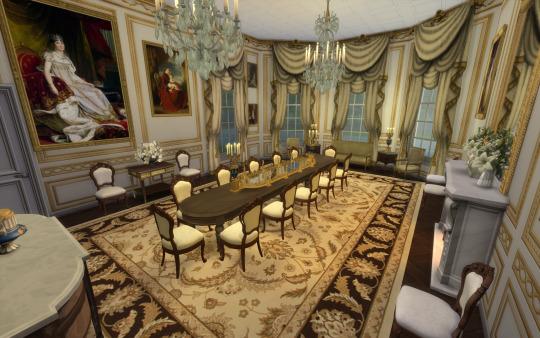








History of the house: Halton House is a country house in the Chiltern Hills above the village of Halton in Buckinghamshire, England. It was built for Alfred Freiherr de Rothschild between 1880 and 1883. It is used as the main officers' mess for RAF Halton and is listed Grade II* on the National Heritage List for England.
There has been a manor house at Halton since the Norman Conquest, when it belonged to the Archbishop of Canterbury. Thomas Cranmer sold the manor to Henry Bradshaw, Solicitor-General in the mid-16th century. After remaining in the Bradshaw family for some considerable time, it was sold to Sir Francis Dashwood in 1720 and was then held in the Dashwood family for almost 150 years.
The site of the old Halton House, or Manor, was west of the church in Halton village. It had a large park, which was later bisected by the Grand Union Canal. In June 1849 Sir George Dashwood auctioned the contents and, in 1853, the estate was sold to Lionel Freiherr de Rothschild.
Lionel then left the estate to his son Alfred Freiherr de Rothschild in 1879. At this time the estate covered an approximately 1,500-acre (610-hectare) triangle between Wendover, Aston Clinton, and Weston Turville.
It is thought the architect was William R. Rodriguez (also known as Rogers), who worked in the design team of William Cubitt and Company, the firm commissioned to build and oversee the project in 1880. Just three years later the house was finished.
The house was widely criticised by members of the establishment. The architect Eustace Balfour, a nephew of the Marquess of Salisbury, described it as a "combination of French Chateau and gambling house", and one of Gladstone's private secretaries called it an "exaggerated nightmare".
At Halton all were entertained by Alfred Freiherr de Rothschild. However, Halton's glittering life lasted less than thirty years, with the last party being in 1914 at the outbreak of World War I. Devastated by the carnage of the war, Freiherr de Rothschild's health began to fail and he died in 1918. Alfred had no legitimate children, so the house was bequeathed to his nephew Lionel Nathan de Rothschild. He detested the place and sold the contents at auction in 1918. The house and by now diminished estate were purchased for the Royal Air Force by the Air Ministry for what was even then a low price of £115,000 (equivalent to £7.08 million in 2023 pounds).
Architecture
For the style of the house Alfred was probably influenced by that of plans for the nearly completed Waddesdon Manor, the home of Baron Ferdinand de Rothschild, his brother-in law. While not so large there is a resemblance, but other continental influences appear to have crept in: classical pediments jut from mansard roofs, spires and gables jostle for attention, and the whole is surmounted by a cupola. The front of the house features a porte-cochère. A Rothschild cousin described it as: "looking like a giant wedding cake".
If the outside was extravagant, the interior was no anti-climax. The central hall (not unlike the galleried two-storey hall at Mentmore Towers) was furnished as the "grand salon". Two further drawing rooms (the east and west) continued the luxurious theme. The dining and billiards rooms too were furnished with 18th-century panelling and boiseries. The theme continued up the grand, plaster panelled staircase to the bedrooms. The whole was furnished in what became known as "Le Style Rothschild", that is, 18th-century French furniture, boulle, ebony, and ormolu, complemented by Old Masters and fine porcelain.
A huge domed conservatory known as the winter garden was attached to the house.
For more info: https://en.wikipedia.org/wiki/Halton_House
------------------------------------------------------------------------------



This house fits a 64x64 lot (You can fit the main building to the 50x50 or 50x40 lot if you lose the garden and conservatory)
I furnished just the principal rooms, so you get an idea. The rest is unfurnished so you create the interiors to your taste!
Hope you like it.
You will need the usual CC I use:
all Felixandre cc
all The Jim
SYB
Anachrosims
Regal Sims
King Falcon railing
The Golden Sanctuary
Cliffou
Dndr recolors
Harrie cc
Tuds
Lili's palace cc
Please enjoy, comment if you like it and share pictures with me if you use my creations!
Early access: 08/18/2024
DOWNLOAD: https://www.patreon.com/user?u=75230453
#sims 4 architecture#sims 4 build#sims4#sims 4 screenshots#sims4building#sims4play#sims 4 historical#sims4palace#sims 4 royalty#ts4#sims4life#sims 4 cc#sims 4#sims 4 legacy#sims 4 gameplay#thesims4#the sims 4#ts4cc#ts4 download#ts4 simblr#ts4 gameplay#my sims#sims community#simblr#ts4 screenshots#ts4 legacy
137 notes
·
View notes
Note
hey!! i really love your posts and trust me when i say this but you're practically doing a work of charity by making all these synonym lists. 😩🫶
i was wondering if you could compile monument vocabulary. vocabulary to describe the intricate and exquisite designs inside historical buildings. tysm!
Some Historical Architecture & Interior Design Vocabulary
Acanthus Leaf - A leaf decoration often used on furniture, particularly on brackets and legs.
Acroterium - Originally an ornament on the roof corners of Greek temples. In classical furniture, similar ornaments applied to the top corners of secretaries, bookcases, highboys and other furniture.
Amorini - Cupid ornaments found on Italian Renaissance furniture.
Anthemion - A honeysuckle design from classical Greek decorative motifs. Term refers to any conventional flower or leaf design.
Antique - Could be anything ranging from a piece of furniture to art. The U.S. government considers any item over 100 years old to be an antique, whereas most collectors use 50 years as a benchmark.
Apothecary Chest - A low chest with small drawers that was originally used to store herbs for cooking and medicinal purposes.
Arabesque - Decorative scroll work or other intricate ornamentation consisting of foliage, vases, leaves and fruits, or fantastic human and animal figures.
Baroque - A highly ornate decorative style that originated in Italy in the 1600's. The style is characterized by irregular curves, twisted columns, elaborate scrolls and oversize moldings. The Italian equivalent of French "rococo".
Bibliotheque-Basse - A low cupboard with shelves for books. Doors are often of glass and sometimes fitted with grilles.
Bullate - Having the surface covered with irregular and slight elevations, giving a blistered appearance.
Cabriole leg - An ornamented furniture leg with a double curve structure.
Chevron - A 'zigzag' pattern characteristic of Romanesque decoration that is often carved around pillars, arches and doorways.
Chinoiserie - A European style of design that is meant to mimic elements of East Asian art.
Console table - A freestanding table, often found in the entryway of homes, that typically serves as a space for decorative elements.
Enfilade - A series of rooms that are connected via doorways that align with one another (commonplace in grand castles, like the Palace of Versailles, or even museums).
Etagere - A freestanding or hanging set of open shelves, designed to display trinkets or other decorative objects.
Gilding - A coating with a thin layer of gold or gold-like substance.
Klismos - Ancient Greek style of chair with saber shaped legs splayed at the front and back. The back legs continue up to support a shoulder-height curved back.
Laurelling - A decorative feature using the laurel leaf motif as its basis.
Lozenge - A diamond shaped decorative panel. Term comes from the Middle English word for stone.
Niche - A recess in a wall for displaying a sculpture or other accessory.
Ormulu - A metal resembling gold. Used as mounts and decorative effects on furniture.
Ovolo - A continuous ornament in the form of an egg which generally decorates the molding called the "quarter-round". Eggs are often separated from each other by pointed darts.
Passementerie - Fancy decorative trimmings such as tassels, tiebacks and ribbon.
Régence Style - This furniture style spanned from about 1715 to 1723, when France was ruled by a regent. This style of furniture design was a transition from massive straight lines to graceful curves.
Sconces - A type of light fixture that is fastened to a wall for support.
Swan-Neck Handle - A curved handle popular in the 1700's.
Trompe l’oeil - A technique used to trick the eye into thinking that something flat, like a wall, is actually three-dimensional. This is often achieved through photorealistic painting.
Victorian - An architectural style defined by highly ornamented design and grand, sweeping facades.
Wainscoting - A type of interior wall paneling that covers the lower portion of a wall.
"Traditional" Interior Design
When talking about traditional interior design, most are referencing a design style that originated in the 18th and 19th century throughout Europe. However, it’s worth noting that other cultures have their own versions of a traditional style that may not look the same as this more Western version.
Traditional Design Elements. Though not exhaustive, a traditional interior will often make use of the following elements:
Emphasis on symmetry and order
Traditional architectural details such wainscoting and crown molding
Classic decor elements such as chandeliers and bookcases
Neutral color schemes with pops of bold colors, often in jewel tones
Upholstery and textiles tend to be subtler (cotton, velvet, or wool, for example)
Furniture pieces with traditional silhouettes, though they’re often updated with modern elements or finishes
Layered window treatments and draperies; curtain valances aren’t used often
Classic patterns such as plaids, damask, or florals
Flooring tends to make use of darker wood
Sources: 1 2 3 4 ⚜ More: Notes & References ⚜ Word Lists
Previous posts that include some related words you might find useful:
Some Architecture Vocabulary
Some European Renaissance Art Vocabulary
Some Medieval Art & Architecture Vocabulary: Part 1
Some Medieval Art & Architecture Vocabulary: Part 2
Some Roman Art Vocabulary
Thanks so much for your kind words, you're really sweet! I tried to include a wide range of terminology since you didn't specify which time period you were looking for. Do go through the sources if I wasn't able to include here what you need in your writing. Hope this helps <3
#terminology#architecture#interior design#writing reference#writeblr#dark academia#spilled ink#literature#writers on tumblr#writing prompt#writing inspiration#history#writing ideas#creative writing#writing resources
75 notes
·
View notes
Text
One Night Stand ; 15

➥ rundown ; as if the unexpected twist of a one-night stand turning out to be your CEO boss wasn't surreal enough, the situation takes a more challenging turn when both of you discover that you're expecting his child.
→ genre ; enemies to lovers | CEO au | pregnancy trope | slowburn
→ Jungkook x y/n → contains smut, fluff and angst → Chapter fifteen ; wc | 6.6 k
primarily on Wattpad
index ⇢ next chapter

Did he sleep? Not so well, but did you sleep? Not at all. The hunger kept you up all night, and you were determined not to have anything. No room service, nothing. When you're adamant, then you don't second guess your decisions even though they seem stupid. Like, you not only starved yourself but your baby was in hunger too, how could the kid get nutrients when you don't ingest a thing.
Curled up on your bed, you looked out the window, watching the Eiffel Tower and how the sun was slowly seeping through the metal holes of the iconic landmark. Jungkook, on the other hand, was buttoning up his inner waistcoat.
What woke him up at 6 was the phone call by his secretary, who had just landed in France. He grabbed his phone and was about to head out when he was met with the hotel staff.
"Good morning sir, your breakfast will be sent to your room in a few minutes-" "That's great, I'll be heading out now. So if it's possible to place the breakfast on the table inside?" "of course, sir, will do." Jungkook thanked the man before he left to get the elevator.
He's never late for meetings. He was glad that the hotel was just a few minutes away from Mr Lim's residence, so there was nothing to worry much about.
"Mr Jeon?" Sana, the newly replaced secretary, stood at the entrance of the hotel, walked up to Jungkook. "Ms Min, hope the journey went smoothly?" "yes, it was Mr. Jeon, thank you for asking." The woman battered her eyes, talking to Jungkook in a more honeyed voice than she usually uses,
attempting to get his attention, but in fact, his eyes remained on his phone. Sana rolled her eyes and heaved a sigh, but she was definitely not gonna stop her attempts especially since she's got the benefit of doubt at the female restroom when she passed by Mr Jeon who walked out of the room.
"The driver is here." She mutters, and Jungkook lets her take a seat first, following her later. Mr Lim was best known for his latest designer fashion brand, Thriveworks that launches tonight, Mr Jeon was invited for the grand opening of the fashion show for the summer campaign pieces that Jeon Industries had created for the kick off of the collection.
Lim Seong wan shares his greeting with Celeste Montpellier, the Co-Ceo of Thriveworks, originally born and raised in France, sharing the joint Ceo position with the half korean-half french 56 year old man Seong an jun. "Greetings, Mr Jeon, it's a pleasure to meet you. I trust you had a safe journey." Mr Montpellier spoke, sharing a smile with the man beside him.
He had a fair stubble and a french crop haircut that slightly outgrown its style, combed and gelled up well, his ebony suit, accentuating his broad shoulders. the accessories that rest on his fingers and ears, though, leave him looking questionable to Jungkook as his fingers were wrapped around by a couple of rings in each finger of silver that glint in the rising sunlight.
The man beside him had a simple suit on with no presence of accesories. He definitely looked older than his age. "of course I did." Jungkook accepted the offer of a hand shake and followed the men inside the building, as Mr Jeon took his time to look around the interior of the room, it made him feel confident about his decision on allowing the two ceos to invest in his business as the two of them hold a highly reputed name in the fashion industry. "Please make yourself comfortable, Mr. Jeon."
Lim speaks as he takes a seat in front of the man. the room served its best creativity in sophisticated as the designer pieces of past and current fashion were displayed ever so thoughtfully, showcasing how this business has grown through each art of seamless garments beautifully resting in each of their own mannequins, waiting to be arranged at the main gala at the show this night,
for which ceo Jeon Jungkook has its special appearance to not only promote his agency but to also add a layer of excitement to it, bringing more fame, fans and charisma like the aura of ceo Jeon. "And the lovely lady, please take a seat."
"Thank you, Mr Celeste, it's a pleasure to meet you. You can call me Sana, Mr Jeon's personal assistant." the woman blabbered when she was not asked to. Jungkook glances over at her, rethinking his decision because he does not get the best vibes. she was not exactly Jungkook's type of secretary. He looked forward to a quiet, soft-spoken woman who would focus on her job, speak when she's asked to, and behave like she had to. he didn't even mind a bubbly natured personality.
However, Sana was the opposite of everything he sought. Jungkook notices how she batters her eyes, too, and he's fully convinced that he needs a new PA as soon as he steps at korea. "we may have emailed the invitation to you, but as a personal gesture of gratitude, we offer this invitation card which was specifically designed to invite ceo jeon to our show to express our sincere admiration to your work."
Celeste spoke in his fluent English with a hint of his French accent that added cherry to his words.
Jungkook felt grateful to have worked with amazing people like them who really acknowledged him, his company, and his artwork of the team. Even though he sits there with a cold look on his face, expressionless and no smile, he feels it within him and he's proud of his team that he got this opportunity and is being appreciated well. The server walks into the room after she's excused, leaving a large tray with a variety of appetisers and desserts that are followed by more items being placed by the next two servers.
The food stares at Jungkook like he does. It's almost telling him something that he really doesn't seem to understand. He does feel that, in fact, he's missing out on something. continuing to look at the food being placed on the table, it hits him. it totally slipped out of his mind that you probably haven't eaten anything since last night. his eyes widened at the thought of leaving you in hunger,
yet he turned away and heard Mr Seong Wan speak, allowing his thoughts to fly away. It's her adamant nature that has put her into that position, giving her a good opportunity to think through her mistakes and reform herself.
In about 15 minutes in from his thoughts he somehow feels guilty that you're probably still asleep, starving cause he knows that you're slowly growing your cravings so he decides to take you for a brunch once this meeting is over.
-
you watch the few tiktoks that pop up in your fyp. It's food, and you can't even express how empty your stomach is. you're aware that Jungkook is out for his work, you're mad at him of course you are, he's putting rights on you for no damn reason. it's not fair to you when you just wanted to explore the city and have food. Is it a crime for a pregnant woman to want to try new food?
The frustration you have on him is at level 05 that if you see him, you're unsure how you would behave, might throw that expensive flower pot at his face. there when you just swipe up your phone, you hear the doorbell ring. taking a look at the time on your phone, you're sure that it can't be Jungkook, it's just 9.45 he wouldn't be back until 10;30 the least. so you walk to the door, wearing that little short and the long white shirt you chose to stay in as it satisfied your comfort zone.
Opening the door slightly you've met with a man dressed in a tailor fitted suit, his hands stayed cosy inside the pockets of his pants, his loafers had been polished well and when you look up to see the man's face, you've met with a stern, cold expression frowning. Jungkook. you rolled your eyes and were about to close the door to his face when he stopped the door with his arm. "Dress up, we're going out." He mumbles and squints your eyes, wondering if you heard him, right? 'wanting to go out now? did he pity me?' "no thanks, i'm good."
you responded as you tried to close the door with force, but his strength was multiplied by yours, so you gave up and walked inside. Jungkook didn't use this opportunity that allowed him to walk inside. He maintained his distance and stood at the doorstep, trying to be patient when he could definitely feel his temper lose. "I'm making use of the free time we have. Don't be a prick. let's go." "sorry that you're wasting your free time on me, Jungkook, you don't have to.
I didn't ask for it." yelling to him, you sit on the couch with your arms crossed and towards your chest. He leans against the door, his shoulders slouching as he lacks a good conversation with you. He's clearly tired of your behaviour, he doesn't enjoy this, for one bit. There's only a limit everyone has, and you've surely crossed it months ago. He can't blame the pregnancy that's allowing you to conduct these actions. You've always been arrogant, picky, and stubborn with what you want.
it's just the way you are, and he feels sorry for the one who falls in love with you. it's a black hole that no one would manage to climb out of. The silence between the two of you gets heavy. A good 15 minutes vanished in this polluted air of tension, annoyance. Jungkook gets tired of watching the ground and walls, he's been staring at it for long that he'd managed to get a count of the geometric circles of the traditional patterned carpet that lays on the files. He'd had enough of this, so he walked inside.
There, he sees you seated on the couch with your legs crossed and folded arms, watching out the window, with a deep frown that sat on your face. Before he says a word, he licks his lips to prepare for another army of words just in case you had yours ready, too. before either of you could spill out anything,
your stomach rumbled loud, not only leaving Jungkook shocked but surprised you too. you meet his face, and he sees yours, holding his head high as he bites into his inner cheek to prevent himself from unintentionally letting out a laugh to gas up our embarrassment.
"that-" he points at your belly with his index finger while you look at him with red cheeks of shame. "Says enough." gulping down the blob of saliva down your throat, there's no point to win you, you admit it that you are famished so you must lose to eat. Although this argument could go on for days, you give up to satisfy your bottomless pit. With slow nods, Jungkook finally deeply exhales as you agreed to him. He didn't want you to be hungry.
Heck, he wouldn't do this to any human. He walks out of the room after he mumbles, "I'll be waiting out." you watched him step out and then stomp on your feet. you hate losing! but since the result of it is food, at this point, you don't care. it's immature, these arguments. He knows it, so do you, yet it happens? because that's at least allowing you two to talk, if not. if it were peaceful, it would be worse without any words exchanged. with two introverts, especially. or at least to each other.
-
"you're sure you wouldn't feel tired?" you kept whining that you wanted to walk around, to look at the streets and feel the city. Jungkook was not very happy about it, yet he decided to let it sink. do what you want so he doesn't get himself trapped in one of your webs. you are very prone to irritation, and that affects him. you stroll down the streets with Jungkook beside you.
He left his coat back in his room. It's much lighter to be with his shirt and inner waistcoat. you didn't bother to pack lengthy outfits as the sun shines bright even to leave you pouring in sweat. Instead you roam around the lanes dressed up in a relaxed fit cream shorts that had the cotton shirt comfortably tucked in, showing the littlest of the bump and a linen white shirt added a slight touch of polished vibes.
you're comfortable, that's enough, that's all you need. looking over at Jungkook, you really wonder how he looks effortlessly with that suit on, no stain of sweat and even the slightest of it, does not eliminate any odour. It's such a blessing to him. his hands stay inside the pocket of his linen pants while your fingers keep pointing at all the random stuff that comes in front of your eyes. "No way, I see the Eiffel Tower, a mile away."
"No, it's not just a mile away! It just looks closer because it's the tallest building here." you gape at him, stopping your tracks as you face him with a wide mouth. He turns back and looks at you, confused so his eyebrows raise. "what?" "oh my god, Jungkook. Thank you for enlightening me. I totally did not know that it's the tallest building here."
"you're welcome." He responds with a smirk and continues to walk forward, trying his best to stop himself from smiling as the look of your screwed face proves to him that you expected a different reaction from him.
"Jerk." "stupid." you both whispered under your breaths as you walked faster to match up to his pace. The streets are so empty here that it just made you realise how happening Korea is. The city roads of Seoul were always filled with a diverse crowd, various languages filling the air even at 3 am in the night. The neon lights and signs gave colour to the sidewalks whereas in France, it's all hues of beige and cream. quite boring for a young adult as you.
that isn't the same case for Jungkook. However, he didn't mind it. Of course, he prefers Seoul. After all, it's where his heart lives. but he isn't fascinated by anything like you are. He's boring, he admits it. The two of you walk down the streets in silence, a gap in between each other as you admire the surroundings while he just wants you to be done with it so he can go back to the hotel and relax.
"oh my god, do you smell that?" you stop abruptly, and your face suddenly lights up when the aroma of cheesy garlic pizza dough brushes under your nose, calling you to meet it. Jungkook looks at you, taking a deep breath, trying to smell what you're talking about, but he doesn't get it.
he just gets a deep inhale of the smoke the brunette man puffed past Jungkook. "wha-" "pizza!! can i have pizza?" 'Oh not again,' he thinks, rolling his eyes at the mention of pizza. you've been eating way too much of that, and he's not happy about it. 'She's gonna birth a damn cholesterol child if she continues to eat these.' "y/n, let's get you some salad-" "i did not come to freaking Paris to have some leaves?! i need to try some french pizza?" 'Is French pizza a thing? I've heard of Italian pizza but french?' "Let's try a healthier option-" "no, I want pizza!!"
You cross your arms and pull it towards your chest. He knows that look of your face, the deep crease of your forehead, and that pout on your lips while you stare at the ground, not getting what you want. Jungkook knows this is only a move to trap him. He doesn't want you to eat it. Heck, he wouldn't want anyone to eat such oily, nasty, junk food.
but he's nothing next to you. He must think quickly. if not pizza, then you're just directly going back to the hotel, empty stomach. He stands in front of you, looking at your face. you're not whiny because that's a part of you.
You're whiny because pregnancy has made you so. Pregnancy brings great changes to women. Some women undergo less to no changes in their moods or behaviour, some of them are always depressed, some are way too happy and some just have attitude problems. with you, you've had an attitude all your life. Things got worse with pregnancy hormones.
"Look, let's get healthy pizza. satisfy you and me." "I'm the pregnant one here, and I'm craving for pizza from this-" you point at the restaurant in front of you.
"is exactly what i'm craving for. I'm not having anything else!" Jungkook knows nothing is in his favour or control and arguing with a woman like you? no chance. He's not taking the risk. He's literally in the middle of the street. You might cry and scream out for help saying he's molesting you or forcing on you.
That's the type you are. "are you sure, maybe there are better places down the-" "a one thousand and two per cent!" "fine." He walks inside the little pizza shop, the doorbell dings letting the staff inside know that they've got new customers.
"Bonjour, what would sir and madame like you have?" the man in the white apron questioned with his strong french accent. you looked around the cosy little space. It definitely looked old, and the walls were all crusty and black, but the look of the freshly baked pizzas was something else. "y/n, come here. What would you like?" you looked at the menu, which showed a wide range of options to choose from,
from a class margherita to a variety of other flavours that looked absolutely mouth-watering. "one margherita and hawaiian pizza, please." Jungkook scrunched his face in disgust. Pineapple on pizza is hideous. "Is that all?" "yes." "dining or takeaway."
"take-" "dining!' you interrupted the man who stood beside you, giving you a glare as he looked around the congested area and sighed. "let's sit out." He nods and does his payment in cash while you walk out and sit on one of the chairs. Jungkook joins in a minute, takes his house out of his pocket, and checks his emails and text messages for clients. "Can I say something?"
his eyes flicker over to you with a nod and then back to his phone. "you're the most boring person I've ever met in my life. My dogs, at their old age, are much more fun than you."
Jungkook puts his phone down and gives you a sarcastic fake smile and then looks at his phone again. "such a nice compliment." "of course, Mr. Jeon." you lean back on the chair, rubbing your belly. That's just a few days away from being 5 months now. you read articles on Google that interest you.
"Y/n?" Jungkook taps on the table, but you don't respond. "Y/n?" Still no answer. "Ms. Lee?" Nothing. "Oh, come on, will you just—" "Huh? What did you just say?" "Finally!" he sighs and rolls his eyes. "Food?" You glance at the table and see the pizza, warm, cheesy, and fresh. Instantly, you set down your phone and grab a slice.
"careful, it's hot!" "ouch-" "see? I told you." Jungkook gestures to you to wait, uses a fork and knife to slowly pull out a triangle, it's hot, and you both could clearly see the smoke gushing out. This only makes you super excited and anticipated. "here." he gives you the paper plate with a slice of a Hawaiian pizza on it, then gets back to his phone. "Hey, grab a piece for yourself, too." "Appreciate your concern, but no thanks." He muttered with a fake smile.
"Try it, Jungkook! I promise it's good!" "I don't think pineapple on my pizza is a good idea. It's a joke. I'm not having it." the both of you were adamant. you cut out a piece and poked your fork into it, bringing it closer to his face, but your arm is only so short. "try it!" "no y/n, do you not understand english?" you've let him go. Clearly, you don't care about him, but you want him to try one of your favourite pizzas.
You want the reaction. simple. standing from your chair, you pull it over to sit beside him. "I will not eat it!" "you must try it!" "no!" "please Jungkook! just one bite, just one!!!" you put the fork to his face, see your face with that pout. "oh, come on, it won't kill you." "fine." He sighs and takes the fork from your hand.
He doesn't want you to feed him, and neither were you planning to. "how. is. it?" you eagerly wait for his reaction as you look at him with wide ears, sparkling in excitement. Jungkook's face scrunches up at first, and then it becomes blank, expressionless. "Tell me!!!" "good."
"what?" "it's good, deaf!" "see, i told you!!! have this piece now." 'oh hell no-' "come on, eat with me, we will obviously not come to Paris again together, so eat up." He looks at your face, like, 'obviously, I'm not taking you anywhere again.' you gobble down the pizza, big bites that he didn't know that your mouth could open this wide. A little pineapple sticks up your nostril that makes him chuckle, which he soon bites back.
"I know it's stuck up there. don't laugh." "so take it off!" "shut up!!" the both of you giggle while he has his share of the pizza, too.
;
"Wait, is that Mr. Jeon? Who's with him? huh? is that? is Mr. Jeon in a fucking relationship? oh, my fucking- let me snap this."
next chapter ⇢
#bts#btswritersclub#bts fanfic#jungkook#one night stand#jungkook fanfic#jeon jungkook#theagstd#jungkook x y/n#jungkook x reader
62 notes
·
View notes
Text
Things the Biden-Harris Administration Did This Week #28
July 19-26 2024
The EPA announced the award of $4.3 billion in Climate Pollution Reduction Grants. The grants support community-driven solutions to fight climate change, and accelerate America’s clean energy transition. The grants will go to 25 projects across 30 states, and one tribal community. When combined the projects will reduce greenhouse gas pollution by as much as 971 million metric tons of CO2, roughly the output of 5 million American homes over 25 years. Major projects include $396 million for Pennsylvania’s Department of Environmental Protection as it tries to curb greenhouse gas emissions from industrial production, and $500 million for transportation and freight decarbonization at the ports of Los Angeles and Long Beach.
The Biden-Harris Administration announced a plan to phase out the federal government's use of single use plastics. The plan calls for the federal government to stop using single use plastics in food service operations, events, and packaging by 2027, and from all federal operations by 2035. The US government is the single largest employer in the country and the world’s largest purchaser of goods and services. Its move away from plastics will redefine the global market.
The White House hosted a summit on super pollutants with the goals of better measuring them and dramatically reducing them. Roughly half of today's climate change is caused by so called super pollutants, methane, hydrofluorocarbons (HFCs), and nitrous oxide (N2O). Public-private partnerships between NOAA and United Airlines, The State Department and NASA, and the non-profit Carbon Mapper Coalition will all help collect important data on these pollutants. While private firms announced with the White House plans that by early next year will reduce overall U.S. industrial emissions of nitrous oxide by over 50% from 2020 numbers. The summit also highlighted the EPA's new rule to reduce methane from oil and gas by 80%.
The EPA announced $325 million in grants for climate justice. The Community Change Grants Program, powered by President Biden's Inflation Reduction Act will ultimately bring $2 billion dollars to disadvantaged communities and help them combat climate change. Some of the projects funded in this first round of grant were: $20 million for Midwest Tribal Energy Resources Association, which will help weatherize and energy efficiency upgrade homes for 35 tribes in Michigan, Minnesota, and Wisconsin, $14 million to install onsite wastewater treatment systems throughout 17 Black Belt counties in Alabama, and $14 million to urban forestry, expanding tree canopy in Philadelphia and Pittsburgh.
The Department of Interior approved 3 new solar projects on public land. The 3 projects, two in Nevada and one in Arizona, once finished could generate enough to power 2 million homes. This comes on top of DoI already having beaten its goal of 25 gigawatts of clean energy projects by the end of 2025, in April 2024. This is all part of President Biden’s goal of creating a carbon pollution-free power sector by 2035.
Treasury Secretary Janet Yellen pledged $667 million to global Pandemic Fund. The fund set up in 2022 seeks to support Pandemic prevention, and readiness in low income nations who can't do it on their own. At the G20 meeting Yellen pushed other nations of the 20 largest economies to double their pledges to the $2 billion dollar fund. Yellen highlighted the importance of the fund by saying "President Biden and I believe that a fully-resourced Pandemic Fund will enable us to better prevent, prepare for, and respond to pandemics – protecting Americans and people around the world from the devastating human and economic costs of infectious disease threats,"
The Departments of the Interior and Commerce today announced a $240 million investment in tribal fisheries in the Pacific Northwest. This is in line with an Executive Order President Biden signed in 2023 during the White House Tribal Nations Summit to mpower Tribal sovereignty and self-determination. An initial $54 million for hatchery maintenance and modernization will be made available for 27 tribes in Alaska, Washington, Oregon, and Idaho. The rest will be invested in longer term fishery projects in the coming years.
The IRS announced that thanks to funding from President Biden's Inflation Reduction Act, it'll be able to digitize much of its operations. This means tax payers will be able to retrieve all their tax related information from one source, including Wage & Income, Account, Record of Account, and Return transcripts, using on-line Individual Online Account.
The IRS also announced that New Jersey will be joining the direct file program in 2025. The direct file program ran as a pilot in 12 states in 2024, allowing tax-payers in those states to file simple tax returns using a free online filing tool directly with the IRS. In 2024 140,000 Americans were able to file this way, they collectively saved $5.6 million in tax preparation fees, claiming $90 million in returns. The average American spends $270 and 13 hours filing their taxes. More than a million people in New Jersey alone will qualify for direct file next year. Oregon opted to join last month. Republicans in Congress lead by Congressmen Adrian Smith of Nebraska and Chuck Edwards of North Carolina have put forward legislation to do away with direct file.
Bonus: American law enforcement arrested co-founder of the Sinaloa Cartel, Ismael "El Mayo" Zambada. El Mayo co-founded the cartel in the 1980s along side Joaquín "El Chapo" Guzmán. Since El Chapo's incarceration in the United States in 2019, El Mayo has been sole head of the Sinaloa Cartel. Authorities also arrested El Chapo's son, Joaquin Guzman Lopez. The Sinaloa Cartel has been a major player in the cross border drug trade, and has often used extreme violence to further their aims.
#Joe Biden#Thanks Biden#kamala harris#us politics#american politics#politics#climate change#climate crisis#climate action#tribal rights#IRS#taxes#tax reform#El Chapo
771 notes
·
View notes
Text
Michael Sainato at The Guardian:
Donald Trump’s administration could rack up a “monumental” bill and is breaking the law by firing government workers on spurious grounds, according to a top labor lawyer. Officials have cited “poor performance” when terminating thousands of federal workers. In many cases it’s not true, according to employees embroiled in the blitz, many of whom are now seeking legal advice. Jacob Malcom was acting deputy assistant secretary for policy and environmental management, and director of the office of policy analysis at the US Department of the Interior – until this week, when he resigned in protest against the mass firings of probationary employees. “This is being done under the guise of ‘poor performance’ or ‘skills not aligned with needs’ but neither are true,” he told the Guardian. “First, no evidence was provided that would suggest that poor performance; in fact, I know some of the individuals that were down my chain of supervision and know they were among the best performers. “Second, [there has been] no evidence or analysis of a lack of alignment with needs. Some of the people terminated in my chain actually work on performance and efficiency, so they literally work on the public argument of the Doge.” The so-called “department of government efficiency”, a unit led by billionaire tycoon Elon Musk, has been permitted by Trump to conduct a wide-ranging blitz across the federal government in the name of improving efficiency. But Suzanne Summerlin, a labor attorney, said an “astounding” level of “fraud, waste and abuse” had been occurring as the Trump administration sought to overhaul a string of departments and agencies. “These firings they’re conducting without following the law will result in hundreds of thousands of former federal employees being owed back pay, plus interest, plus benefits, plus attorneys fees,” said Summerlin. “When the bill comes it will be monumental.”
The Trump-Musk-Vought mass purges from federal government could be very costly.
93 notes
·
View notes
Text
How rich is Tony Stark?
Throughout his superhero career, Tony's net worth in the MCU has always been between $10 and $20 billion. How much is that? Let's talk about Tony Stark's real financial resources and purchasing power.

The numbers themselves don't tell us anything, so we'll compare. Some real billionaires are much richer than him (Elon Musk - $210 billion, Jeff Bezos - $195 billion, Bill Gates - $129 billion). Huge difference, don't you think?
Let's list Tony's expenses: he founded and funded Damage Control. He covered the cost of the destruction caused not only by the Avengers, but by everyone they fought. He funded scientific projects and charitable foundations. He covered all the Avengers' expenses (compound, equipment, tech, vehicles, quinjets, food, medical and legal services, staff, team members' salaries, etc.). He made Iron Man suits and equipment for himself, Peter, Rhodey, and later Pepper. It takes a LOT of money to cover all of this. And it's all pure expense. He didn't make any profit from it.

Reminder: He's not nearly as rich as Musk, Bezos or Gates. How much can these guys do, buy and finance? Less than you think. Now divide by 10 to get an idea of how much Tony could.
I'll help you: we'll count in Helicarriers. Let's say Tony had $20 billion (that's max). The price of one real aircraft carrier is 13 billion dollars. Helicarriers, even the basic ones (from The Avengers and AoU), are much more advanced (they fly, have retro-reflective panels that cover them entirely, and have a fancy interior with expensive equipment on board). It will cost much more. Let's give it a price tag of $20 billion. That is - Tony could only buy 1 Helicarrier and get $0 in his bank accounts.
Or another example: how much did the Battle of New York cost? Secretary Ross showed us - $88 billion in property damage. Tony would need another $70 billion to cover the cost of this one battle.

BUT let me tell you, his $10-20 billion isn't even real money. It's net worth. He would never have seen that $10-20 billion in cash or been able to use it. Because these are assets: shares and property he had. He would have to sell them, then pay taxes, and only then would he see the actual amount of money he could use. Which is about half of the net worth - $5-10 billion. Thus, his purchasing power would amount to a small insignificant fraction of the Battle of New York, or 0 Helicarriers, or even 0 real-life aircraft carriers. That's it. This is why the Avengers never had their own Helicarrier - Tony COULD NOT AFFORD ONE.
He didn't have unlimited resources. He couldn't buy everything. Stop imagining him as Scrooge McDuck. He had to work several jobs to provide for the team and protect the Earth. Alone. Where were Thor and Black Panther's resources?
Conclusion: no, Tony wasn't that rich. He worked his butt off to be a wallet of Earth's protection, in addition to being its shield. Remember that.
108 notes
·
View notes